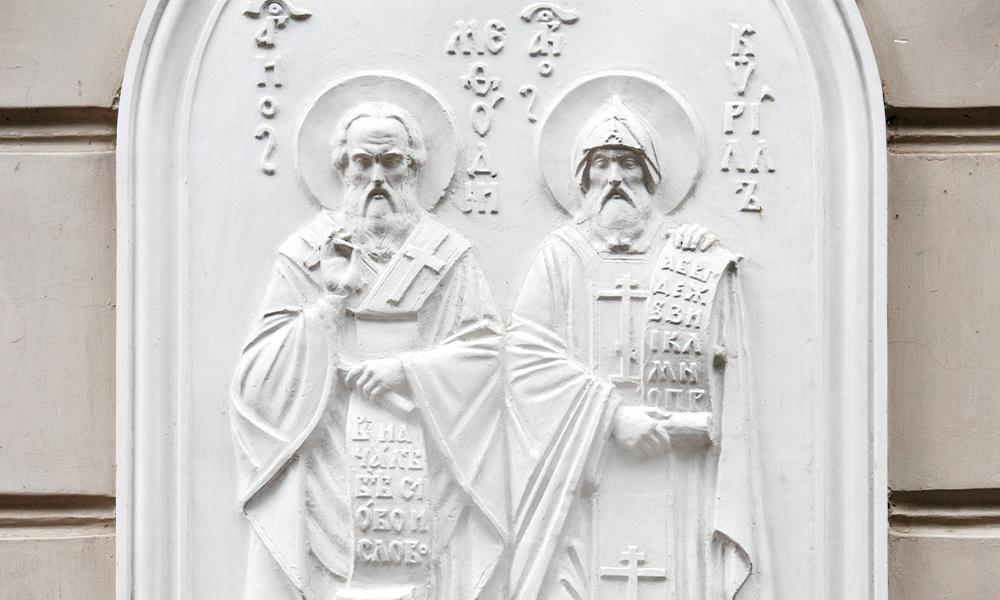
A Day to Celebrate Co-Patrons
One wintry afternoon, a student docent at the University of Pittsburgh’s Cathedral of Learning ushered visitors into the Slovak heritage room. She remarked on an icon of Slovakia’s patron saints that was exhibited there and pronounced their names as Cyril and Melodious.
One wintry afternoon, a student docent at the University of Pittsburgh’s Cathedral of Learning ushered visitors into the Slovak heritage room. She remarked on an icon of Slovakia’s patron saints that was exhibited there and pronounced their names as Cyril and Melodious.
In another part of the state, slightly west of the Poconos, a radio announcer was listing schools closed for a snow day. He identified one of them as Sts. Cereal and Methodist School.
As a longtime member of a religious community named Sisters of Sts. Cyril and Methodius, I’m no stranger to these comical mispronunciations. I’m altogether familiar with attendees at daily Mass who continue to wonder how two Greek brothers managed to displace Valentine from a festive observance of Feb. 14. But there they are — two evangelists whom St. John Paul II named, along with St. Benedict, co-patrons of Europe, celebrated by the Church on a day of flowers, chocolates and heart-shaped candy.
The story of these saints takes us back to the ninth century and the Byzantine empire, which was concerned for the spread of the Gospel among Slavic peoples in Central and Eastern Europe. Cyril and Methodius were known in imperial circles. Scholarly Cyril had been nicknamed “the Philosopher” as he served as a librarian and then professor in the court. Methodius was an accomplished public administrator. We are not certain at what point both were ordained priests, but we do know that they made a prompt response to the appeal to go on mission.
Aside from gearing themselves up for long and arduous journeys through what was then called Pannonia and Great Moravia, they resolved to share their faith in the language of the people. To accommodate sounds in Old Slavonic, which were not typical of Greek and Latin, Cyril developed what became known as the Cyrillic alphabet — the one we see wherever the Russian language appears in print.
Cyril translated the Book of the Gospels and liturgical books into Old Slavonic to assure that an unlettered peasantry would be able to understand the Word proclaimed, preaching and public worship. This was a controversial move at the time. They sought and, after considerable controversy, received the approval of Pope Adrian II, who blessed their books for use at Mass.
As many of us know, the use of the vernacular — the native languages of peoples — was not approved for widespread use in the Mass until the 20th century and the Second Vatican Council. Cyril and Methodius nearly 1,100 years earlier had pleaded the cause of speaking the language of the people when it came to celebrating the Eucharist and other liturgical rites. It was not to downplay the significance of the classic Latin, Greek and Hebrew, but to acknowledge that many people drawn to Catholicism were not well educated and were monolingual.
Another thing Cyril and Methodius did, as they traversed the part of the world that now includes parts of Poland, the Czech Republic, Slovakia and other Slavic areas was to identify talented, devout youth who were on fire for the faith and showed promise as future priests. They were convinced that mission territories ought not remain beholden to a supply of missionaries but instead rely on their own countrymen who were qualified for Holy Orders. Pope Adrian II arranged for clerics trained by Cyril and Methodius to be ordained, trusting in the doctrinal fidelity and teaching ability of the holy brothers.
Today we see Cyril and Methodius as models of the inculturation of the Gospel. They took it upon themselves to speak the language and learn the culture of the people to whom they were sent on mission. They cleared the way for the development of a truly Christian culture, where the form of greeting became “Praised be Jesus Christ,” and the way of saying farewell was “God be with you” — which, of course, is what “goodbye'' originally meant. The lush embroidery, floral patterns and colors of peasant dress also were incorporated into the design of vestments and liturgical art. The melodies of folk songs made their way into hymns and superstitions were replaced with stories of faith.
Feb. 14 now belongs to Sts. Cyril and Methodius in the Roman calendar due to Cyril’s unexpected death in Rome on that day in 869 A.D. He died a simple monk. Methodius, who died on April 6, 885 A.D., continued his mission after Cyril’s death and held the post of archbishop for his expansive region. The double-barred cross of a metropolitan (archbishop) appears to this day on the flag of Slovakia, mounted atop three mountains, which represent the Tatra Mountains (Tatry) bordering Slovakia and Poland.
For so many, Feb. 14 is a sentimental day. For the sisters in my community, it is a day to express the joy of the Gospel and to recall the many people who are the beneficiaries of a long-ago mission. Of course, we enjoy the chocolate too.
Sister Pamela Smith, SSCM, Ph.D., is the diocesan director of Ecumenical and Interreligious Affairs. Email her at psmith@charlestondiocese.org.
